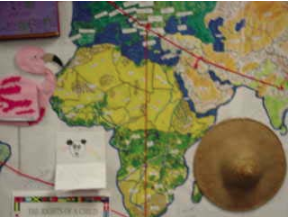
Lights, Camera, Communicate

Overview
During the Global Read Aloud (GRA), students will write scripts, and use the online video platform Flipgrid to communicate with children outside of their classroom, about what they are reading.
Learning Objectives
Students will:
- Be able to use their reading to write scripts.
- Be able to communicate/connect with students in other schools and classes.
Vocabulary
Vocabulary Words:
-
FlipGrid: Flipgrid is a video discussion platform, that allows us to share our thoughts with anyone who has the link to our videos. We will write our scripts and then record with Chromebooks.
-
Audience: Your audience is who will be watching your video, so in this case, other students and teachers that are reading our GRA book. Your video should be appropriate for your audience, so you’ll keep them in mind as you write.
Pre-planning
To prepare for this lesson:
-
The teacher should sign up for the Global Read Aloud (which takes place in October): and find other classes to connect with. Note: You can also connect with other teachers in your building or district.
-
Set up a Free Flip account. (Flip will work on any device with a camera and speaker.)
-
Use the educator guide for assistance using Flip. (Scroll down the page until you see the Educator PDF
- Watch the video tutorial A Quick Start Guide to Flip for Educators
- For a middle school example and additional instructions for Flip use the Gold Empower Student Voice with Flip from the 21 Things 4 Students website.
-
Make a copy of this script template to assist the students as they write their video script.
-
After you have created your copy, you are welcome to customize it for your classroom.
-
If you have a Google Classroom, you can add this document to your classroom and have the students make their own copies to use and share with you.
-
Note: Not only is Fip a great way for students to communicate with a larger audience, but sometimes those connections transfer over into other collaborative projects!
Accommodations
- See the Accommodations Page and Charts on the 21things4students website in the Teacher Resources.
- For students who struggle to express themselves in writing, they could either draw their ideas (to reference during their video) or talk through their ideas with me. Depending on the student’s struggles, you could transcribe for them to read later, or simply probe to get them to share more ideas. The Flip website is extremely easy to use, they basically hit record and stop. However, if this was challenging for a particular student the teacher or a classmate would help them get going.
- Another accommodation, due to FERPA, the teacher who has a student who is not allowed to appear online, they still can record their ideas, but with a prop in front of the camera.
Steps
Directions for this activity:
- The teacher will explain to the students that they will be reading a book to share during the Global Read Aloud. They will share their book using Flip with other fourth-grade students and teachers. The idea is to convince other students to also read the book so they will want to make the video interesting!
- The teacher will set up the class Flip (this shares the topic/directions of what the teacher wants kids to do (write about).
- Once you have set up the grid, share the link with the other classes you’ll be communicating with (it’s that easy).
- Discuss the grid with your students, and have them get busy writing their “scripts" using the script template.
- They love this and usually write more when it’s presented this way.
- Once scripts are complete, find quiet places for students to record and allow time for them to watch each others’ videos...they love it!
Assessment Options
Different options for assessing the students:
- Observations
- Check for understanding
- The teacher can assess the student’s ability to stay on the topic of the grid and communicate clearly with their audience.
- Assess their “script” for their ability to share details, make connections, etc. that pertain to the text.
- From a technical standpoint, you can also assess the relative ease with which they may/may not navigate the website.
MITECS Competencies & ISTE Standards
MITECS: Michigan adopted the "ISTE Standards for Students" called MITECS (Michigan Integrated Technology Competencies for Students) in 2018.
Creative Communicator
6a. Students choose the appropriate platforms and tools for meeting the desired objectives of their creation or communication.
6b. Students create original works or responsibly repurpose or remix digital resources into new creations.
6c. Students communicate complex ideas clearly and effectively by creating or using a variety of digital objects such as visualizations, models or simulations.
6d. Students publish or present content that customizes the message and medium for their intended audiences.
Global Collaborator
7a. Students use digital tools to connect with learners from a variety of backgrounds and cultures, engaging with them in ways that broaden mutual understanding and learning.
Devices and Resources
Device: PC, Chromebook, Mac, iPad
Browser: Chrome, Safari, Firefox, Edge, ALL
Websites:
Flip
Quick Start Guide to Flip for Educators
CONTENT AREA RESOURCES
ELA
Flipgrid helps connect your class to the learning objective about communication. After we read, we talk about what our writing will center on (thoughts about the GRA we wish to share), keeping in mind our audience, and then students write individually. Along the way, I conference with the students and they conference with each other. Final edits are done before they are given the green light to record.
Integrated Arts
Flipgrid is great for all kinds of projects. Students can create an artistic piece of work and then talk about it using Flipgrid to get feedback from their peers and their teacher.
Credits
This task card was created by Susan Howey, Grosse Point Public Schools, July 2019. Updated February 2024.


